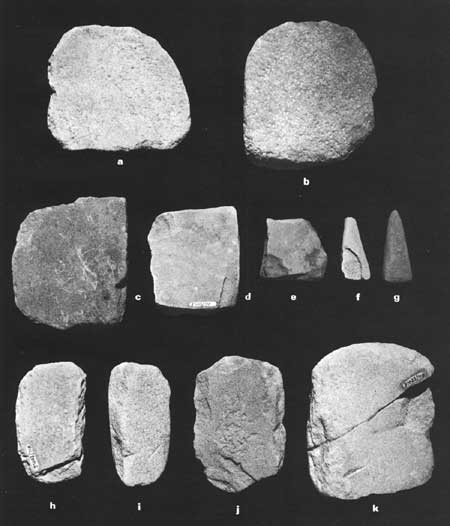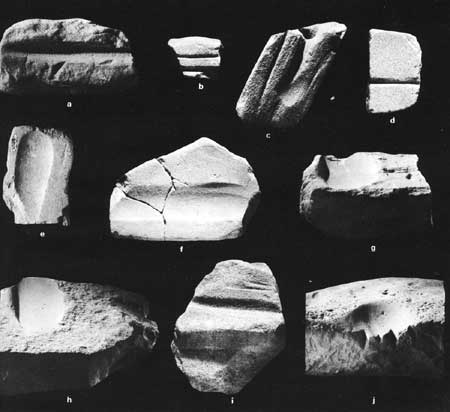|
MESA VERDE
Big Juniper House of Mesa Verde, Colorado Wetherill Mesa Studies |

|
Chapter 4
stone artifacts (continued)
FABRICATING IMPLEMENTS
Stone artifacts were presumably used in the manufacture or preparation of other tools, or in the shaping of building stones. These have been categorized as fabricating implements.
Abrading Stones
A fairly large number of small, gritty pieces of sandstone and occasionally other material were probably used as abraders in shaping or polishing other tools. They have been classified according to the character of the working surface and overall shape.
Flat, tabular abraders. These have one or more flat to slightly concave or convex faces (fig. 107a-e and h-j). The following shapes occurred: rounded (8), oblong (7), subsquare (4), and irregular (5). The dimensions and weights of these abraders are:
| Length (cm.) |
Width (cm.) |
Thickness (cm.) |
Weight (kg.) | |
| Maximum | 12.8 | 11.5 | 4.3 | 0.7 |
| Minimum | 7.4 | 5.1 | 1.4 | .06 |
| Average | 10.1 | 8.0 | 2.5 | .3 |
Flat, irregular abraders. The two examples, one complete and one fragmentary, do not show intentional shaping, but were shaped as a result of wear. One is cone-shaped, the other triangular, with wear on more than one surface (fig. 107f and g).
Abrader from a mano fragment. The end fragment of a Subtype 1A mano was re-used as an abrader (fig. 107k). The broken edge had been partially ground smooth and the opposite face of the mano had a grinding facet similar to those of flat abraders. Its larger size, in addition to being a fragment of another tool, sets it apart from the typical flat abrader.
Saws. Four fine-grained, poorly cemented pieces of sandstone have one or more beveled sides or ends with V-shaped edges that could have been used as saws (fig. 108). One or more of the faces may also be worked or ground and could have been used as flat, tabular abraders. Judd (1954, pp. 124-125) reports similar artifacts from Pueblo Bonito. The range in measurements is: length 5.6 to 9.3 cm; width 2.9 to 7.9 cm; thickness 0.4 to 0.8 cm; and weight 18 to 66 gm.
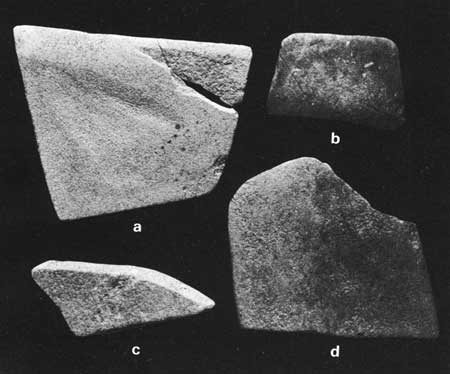
|
| Fig. 108 Saws. Length of a 9.3 cm. |
Whetstone. One relatively long, subrectangular abrader has been tentatively identified as a "whetstone" (fig. 109). It has a rippled surface with the ridges highly ground as if another tool had been rotated while being sharpened or ground in a reciprocal motion on it. The ripples are more or less at right angles to the long axis of the whetstone. The sides and ends have been shaped by bifacial chipping, followed by light grinding. The material is fine-grained, well-cemented sandstone, harder than most of the abraders.

|
| Fig. 109 Whetstone. |
The whetstone could have been held easily in one hand with whatever was being worked held in the other hand. It is tabular in form, but longer than the flat, tabular abraders. It measures 17.5 by 6.5 by 1.2 cm., and weighs 304gm.
Grooved abraders. Pieces of gritty, poorly cemented sandstone with a variety of grooves have been divided into four groups: narrow-grooved, medium-width grooved, broad-grooved, and combination-grooved abraders.
Of the four artifacts in the narrow-grooved abrader group, two have two grooves and two have one groove each (fig. 110a-d). The widths of the grooves range from 0.2 to 1.5 cm., with most of the grooves about 0.3 cm. wide and tapering at the ends. The depth varies from 0.05 to 1.0 cm., the mode being about 0.2 cm. The groove lengths range from 3.3 to 14.4 cm., the average measuring about 6.3 cm. The longest is concave, and the others are flat, in longitudinal section. Three are V-shaped and three are rounded or U-shaped in transverse section. The paired grooves in two abraders are V-shaped and U-shaped in each case. Three of the grooves are open at both ends, and three are open at one end and closed at the other.
One of the grooved abraders (fig. 110d) was shaped by grinding both faces and three edges. It may have been used also as a flat, tabular abrader. This is similar to Woodbury's "transversely grooved shaft smoother," but the groove width is narrower than in his type (Woodbury, 1954, pp. 107-109, fig. 22j-p).
The other narrow-grooved abraders are unshaped blocks of sandstone, two small and one large. The shaped, narrow-grooved abrader and the two smaller unshaped abraders could have been held conveniently in one hand. The large abrader could have been propped up on edge between the knees or with one end buried in the ground (fig. 110a). One of the abraders (fig. 110c) had a natural hole in one end, which showed some minor wear on its perimeter.
The narrow widths of most of the grooves suggest use in the manufacture of bone awls or needles. They were probably too narrow to be used as arrowshaft smoothers or for other wooden objects such as spindles or prayer sticks. The one groove (fig. 110a) that is wider than the others could have been used for such artifacts, but its concave long section would be unsuitable for shaping or smoothing artifacts which are straight, such as arrow-shafts or spindles. Most of the wooden artifacts mentioned above, excavated from Wetherill Mesa sites, show relatively little of the characteristic abrasion which would indicate they had been worked in grooved stone abraders. However, bone and wooden awls and bone needles show abrasion marks that indicate they were probably caused by narrow-grooved abraders.
As the term suggests, medium-grooved abraders are intermediate between the narrow- and broad-grooved abraders (fig. 110e and f). Six medium-grooved abraders with 10 grooves were found. Groove widths range from 3.0 to 7.0 cm., and average approximately 5.6 cm. Groove depths range from 0.3 to 0.8 cm., and average about 0.6 cm. Transverse sections are U-shaped and sometimes very shallow. Longitudinal sections are flat or concave. Groove lengths range from 9.3 to 25.5 cm. on the three specimens which have complete grooves.
Some of the medium-width abraders may have served as ax sharpeners and polishers, and others could have been used for shaping bone scrapers (ch. 5), as well as other bone and wooden objects.
The six specimens in the broad-grooved abrader group have one groove each (fig. 110g and h). Groove widths range from 8.8 to 12.0 cm., with the average approximately 10.4 cm. Groove lengths range from 11.5 to 26.0 cm., and average about 18.7 cm. Depths are from 0.7 to 2.1 cm., with the average approximately 1.4 cm.
The grooves are concave in transverse section with one side steeper than the other, and concave in the longitudinal section. Five of the broad-grooved abraders are irregular blocks or slabs of gritty sandstone. The sixth was ground into the working surface of a fragmentary troughed metate.
Broad-grooved abraders were probably used in shaping and polishing axes and possibly shaping some of the manos. These "portable" abraders are much more common at mesa-top sites than in the cliff ruins, where exposed sandstone and large boulders were often used.
Two specimens have narrow and medium grooves, and one specimen has narrow grooves and one broad groove (fig. 110i and j). The latter has five narrow grooves, four of which were at the open end of a broad groove (fig. 110j). One of the other abraders has three narrow grooves, one of which is 1.3 cm. wide and the other two are about 0.05 cm. wide. The medium groove next to them is partly broken but probably once measured about 5.0 cm. in width (fig. 110i).
The other abrader has a very shallow medium groove about 3.8 cm. wide in the middle and a shallow groove about 1.5 cm. wide in one corner. This specimen is unusual in being flatter and more regular than the other abraders in this group.
Rubbing and Polishing Stones
The fragment of an elongated cobble of feldspar amphibole was classified as a rubbing stone (fig. 111j). One face shows numerous striations with no apparent alinement, probably resulting from use; and the ends and one side are pecked and battered, suggesting that the object was also used as a hammerstone. Measurements are 8.9 by 4.0 by 2.8 cm., and 248 gm.

|
| Fig. 111 Polishing stones, a-i, and rubbing stone, j. Length of e is 9 cm. |
Nine waterworn pebbles were identified as polishing stones (fig. 111a-i). Six of these show only very slight striations on one or more surfaces. A broken pebble has striations on one unmodified surface and a wear facet on one side of the broken edge (fig. 111d). One pebble is irregular and flat, with some chipping at the narrow end; all the surfaces show signs of wear, even over the chipping (fig. 111e). One stone is rectangular, with chipping on one end; all the surfaces and the chipped area are worn and faceted from polishing (fig. 111f). The materials are quartz (1), quartzite (2), and chert (6). These tools were probably used for polishing pottery and stone artifacts, such as axes or hammers, and possibly for grinding pigments.
Notched and Grooved Hammers
The 15 notched and grooved hammers in the collection (fig. 112) include the following varieties: notched at one side (2), of coarse-grained igneous rock; notched at both sides (6), three of sandstone, one of quartzite, and two of coarse-grained igneous rock; partially grooved (2), of sandstone; full-grooved (2), one of sandstone and one of fine-grained igneous rock; and dulled and wornout axes (3), one of quartzite and two coarse-grained igneous rock. All the specimens, with the possible exception of one of sandstone, were made of river cobbles.

|
| Fig. 112 Notched and grooved hammers. Length off is 18.7 cm. |
The term "partially grooved" designates tools with a groove on part or all of one face only. Three-quarter grooved hammers and axes have not been found in any of the Mesa Verde sites and are absent or extremely rare throughout the rest of the Mesa Verde region. Side notches are usually directly opposite each other, and one of the notches is commonly wider than the other.
The following are dimensions of notched and grooved hammers:
| Length (cm.) |
Width (cm.) |
Thickness (cm.) |
Weight (kg.) | |
| Maximum | 18.7 | 10.1 | 5.4 | 1.3 |
| Minimum | 8.0 | 5.0 | 2.8 | .2 |
| Average | 12.2 | 7.3 | 3.8 | .6 |
Hammerstones
A number of stone artifacts of various sizes and degrees of wear were classified as hammerstones, one of the ubiquitous stone tool types at Mesa Verde. I found no suitable method of classification of hammerstones on the basis of shape. Shape was primarily due to the amount and kind of wear, with gradations from extremely angular to an almost spherical shape with all of the original angularities battered and worn down.
Some 215 stone artifacts were classified as hammerstones. Five groups are recognized: rough hammerstones of three types, including re-used tool fragments; discoidal, and pitted hammerstones.
These tools were undoubtedly used for a variety of purposes, such as sharpening manos, metates, and unspecialized milling stones. They probably were used also in dressing masonry slabs and blocks for walls, in breaking up stones for various flake and core tools, and for shaping many stone tools such as axes, manos, and metates, many of which show traces of pecking.
Rough hammerstones, Type 1. Ten river cobbles with their basic shapes unchanged, and very little modification except for some pecking or battering at one or two ends or sides, were classified as Type 1 (fig. 113a-c). There were five cobbles of sandstone and five of quartzite. Two of these hammerstones would have been classified as handstones or discoidal hammerstones if they had possessed the characteristic striations from use in grinding or polishing operations.

|
| Fig. 113 Rough hammerstones, Type 1, a-c; rough hammerstones, Type 2, d-g; and discoidal hammerstone, h. Length of a is 8.1 cm. |
The following are dimensions and weights of rough hammerstones, Type 1:
| Length (cm.) |
Width (cm.) |
Thickness (cm.) |
Weight (kg.) | |
| Maximum | 15.5 | 9.3 | 7.9 | 4.8 |
| Minimum | 7.3 | 5.7 | 2.2 | .2 |
| Average | 9.6 | 7.1 | 4.6 | .6 |
Rough hammerstones, Type 2. The 171 hammerstones in this group (figs. 113d-g, and 114) were made of the following materials: quartzite (35), quartz (1), sandstone (20), coarse-grained igneous rock (19), fine grained igneous rock (1), chert or claystone (95). Most of the hammerstones were black or dark gray-brown. The others were yellow-buff to red-brown, with some banded-color cherts.
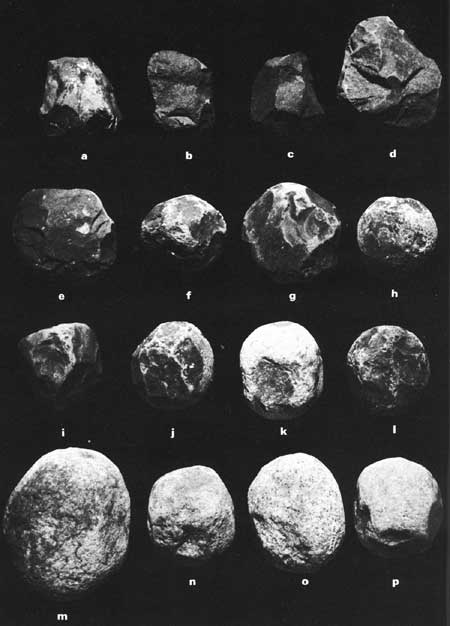
|
| Fig. 114 Rough hammerstones, Type 2. Length of m is 9 cm. (click on image for an enlargement in a new window) |
Shapes varied from almost spherical to irregular. Type 2 rough hammerstones were spalled to produce sharp and protruding edges which in turn were battered down to a varying degree of regularity, depending upon the amount of use. Fourteen were discoidal-shaped, but did not have any grinding surface or surface flattened by rubbing or grinding as did the "discoidal hammerstones" described by Woodbury (1954, p. 90) (fig. 113d-g). However, one discoidal hammerstone was excavated and will be described later. A sequence of varying degrees of wear is shown in figure 114.
The following are dimensions and weights of rough hammerstones, Type 2:
| Length (cm.) |
Width (cm.) |
Thickness (cm.) |
Weight (kg.) | |
| Maximum | 11.4 | 10.5 | 8.0 | 1.2 |
| Minimum | 3.8 | 3.1 | 1.3 | .05 |
| Average | 6.4 | 5.4 | 4.0 | .2 |
Rough hammerstones, Type 3. Apparently a broken or wornout tool was not discarded if it could be used for another purpose. Twenty-two fragments of other tools were re-used as hammerstones (fig. 115). The following original tools are represented: hafted tools, probably predominantly hafted hammers (17), choppers (3), hand-stones (1), and scraper planes (1). The materials were: claystone or chert (5), sandstone (4), and coarse-grained igneous rock (13). Two fragments were originally a side-notched hammer which subsequently broke, both halves being re-used as hammerstones (fig. 115c and f).

|
| Fig. 115 Rough hammerstones, Type 3. Re-used handstone, a reused hafted tools, b, c, f, g; re-used plane, d; and re-used chopper, e. Length of e is 9 cm. |
The following are dimensions and weights of rough hammerstones, Type 3:
| Length (cm.) |
Width (cm.) |
Thickness (cm.) |
Weight (kg.) | |
| Maximum | 12.5 | 9.6 | 5.4 | 0.7 |
| Minimum | 4.5 | 4.5 | 1.9 | .1 |
| Average | 7.6 | 6.4 | 3.6 | .3 |
Discoidal hammerstone. One quartzite tool, measuring 8.6 by 6.9 by 3.0 cm. and weighing 0.3 kg. (fig. 113h), was identified as a discoidal hammerstone (Woodbury, op. cit.). It is suboval in outline and shaped by bifacial spalling. The perimeter has light battering or pecking over the spalling. One surface, convex in longitudinal section and flat in transverse section, shows striations resulting from use in grinding.
Pitted hammerstones. Nine whole and two fragmentary stone artifacts were designated pitted hammerstones (fig. 116). One was globular (fig. 116e), one irregular in shape (fig. 116h), and the rest were subrectangular. The globular and irregular specimens were coarse-grained igneous river cobbles. The rest, except for one, were hard, fine-grained quartzitic sandstone river cobbles. The exception was the typical sandstone preferred for manos and metates. Dimensions of the irregular and globular pitted hammerstones are, respectively: lengths 10.0 and 7.9 cm.; widths 8.0 and 7.2 cm.; thicknesses 7.1 and 6.3 cm.; and weights 8.8 and 4.8 kg.

|
| Fig. 116 Pitted hammerstones: subrectangular. a-d, f, g; globular, e; and irregular, h. Lengths: b, 13.2 cm.; f, 18.7 cm. (click on image for an enlargement in a new window) |
The following are dimensions and weights of subrectangular pitted hammerstones:
| Length (cm.) |
Width (cm.) |
Thickness (cm.) |
Weight (kg.) | |
| Maximum | 18.7 | 9.9 | 7.0 | 2.1 |
| Minimum | 9.6 | 8.1 | 4.0 | .5 |
| Average | 13.2 | 8.9 | 5.4 | 1.0 |
The number of pecked depressions, probably used as finger-grips, range from one, on one face of one specimen, to six, with pits on both faces and on the sides and ends (fig. 116b). Most of the pitted hammerstones can be held easily between the thumb on one face and the middle and fourth and fifth fingers on the other face, with the forefinger on one end as shown in figure 117, left. Those with pits on sides and ends could have been rotated between thumb and middle finger, with the forefinger resting in the pit on each side as it is rotated from one position to another. Figure 117, right, shows the probable method of holding the globular pitted hammerstone. Several have one or more faces or edges ground and probably were used also as handstones, rubbing stones, or abraders. One of them (fig. 116g) has a shallow, narrow groove ground on one face from the pit or finger-grip in the middle of the face to one end. All the pitted hammerstones show wear from hammering or battering, particularly on the corners. The globular and irregular pitted hammerstones have extensive wear on the projections.
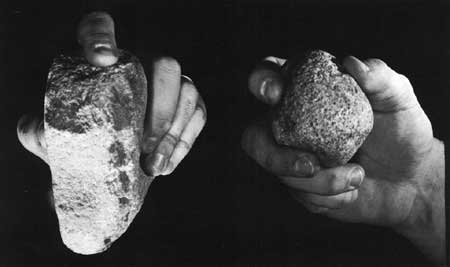
|
| Fig. 117 Probable method of grasping pitted hammerstones: subrectangular hammerstone at left; globular hammerstone at right. (click on image for an enlargement in a new window) |
Axes
Only three axes, two full-grooved and one side-notched, were found (fig. 118). Several others (mentioned previously) were used as grooved or notched hammers after they had lost their sharp bits. One full-grooved ax, made of a quartzitic sandstone cobble, was unfinished (fig. 118a). The bit was pecked from both faces but had not been finished to a sharp edge. Neither the bit nor the groove had any grinding over the pecking or any polishing characteristic of a finished ax.
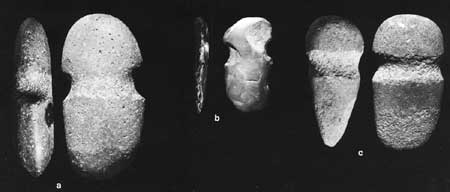
|
| Fig. 118 Axes. Length of c is 14.4 cm. (click on image for an enlargement in a new window) |
Another ax (fig. 118b), of metamorphosed black shale, was probably not suitable for cutting or chopping as the material is brittle and thin. It was also unusual in being shaped by chipping, probably because of its material and size. The bit was ground and polished, with some polishing on other parts of the surface. It is side-notched, with the notches set at an oblique angle to the long axis. There is another poorly defined notch on one side. The ax is crude and not typical of Mesa Verde axes.
The third ax (fig. 118c), made of a coarse-grained igneous river cobble, was nicely finished. It is a full-grooved ax, but the groove is very shallow and lightly ground over pecking on the faces and deep and well ground on the edges. The groove is at right-angles to the long axis. The bit is ground and polished to a sharp edge. The cobble surface has been polished, with the striations from the polishing alined along the long axis on the faces and sides. The ax shows very little evidence of use—only a few small nicks on the bit and very light pecking at the poll.
The following are dimensions and weights of axes:
| Length (cm.) |
Width (cm.) |
Thickness (cm.) |
Weight (kg.) | |
| Coarse-grained igneous ax | 18.4 | 9.0 | 4.3 | 1.3 |
| Quartzitic sandstone ax | 14.4 | 7.4 | 6.3 | .9 |
| Shale ax | 11.7 | 5.2 | 1.4 | .2 |
Bitted Stones
Four bits, probably from axes, were found. All of them show more wear and use than the complete axes. All are of coarse-grained igneous rock.
Notched and Grooved Stones
Eight notched and two grooved artifacts were so fragmentary that it was not possible to determine whether they were parts of axes or hammers. Materials used were: claystone or chert (3), sandstone (2), and coarse-grained igneous rock (5). One of the grooved fragments may have had two full grooves adjacent to one another.
Choppers
The 24 choppers were of 4 types: large cores, small cores, flakes, and reshaped fragments of other tools.
Large core chopper. The single specimen, of dark brown quartzite, measures 8.4 by 7.7 by 3.5 cm. and weighs 359 gm. (fig. 119a). It is roughly discoidal, and approximately one-third of the perimeter has been bifacially spalled and battered.
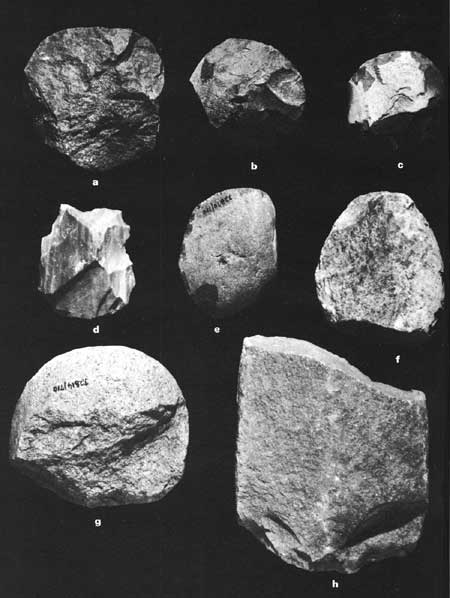
|
| Fig. 119. Choppers. Large core, a; small core, b-d; flake, e, f; re-used handstone, g; and re-used mano, h. Length of h is 13.6 cm. (click on image for an enlargement in a new window) |
Small core choppers. The 15 choppers in this group (fig. 119b-d) are made of claystone or chert (13), quartzite (1), and coarse-grained igneous rock (1). They are all bifacially spalled and battered on at least a third or more of the perimeter.
The following are dimensions and weights of small core choppers:
| Length (cm.) |
Width (cm.) |
Thickness (cm.) |
Weight (kg.) | |
| Maximum | 8.8 | 6.8 | 5.7 | 308 |
| Minimum | 5.2 | 3.5 | 1.3 | 44 |
| Average | 6.4 | 5.4 | 2.7 | 127 |
Flake choppers. The 6 flake choppers (fig. 119e and f) were made of chert or claystone (4) and quartzite (2), and were bifacially spalled on a third to two-thirds of the perimeter. Size and weight ranges are: length 5.5 to 9.5 cm., width 5.1 to 8.4 cm., thickness 2.0 to 2.6 cm., and weight 85 to 281 gm.
Other tools re-used as choppers. A mano fragment and a handstone of quartzitic sandstone were re-used as choppers (fig. 119g and h). They measure 13.6 by 11.5 by 3.8 cm. and 0.9 kg., and 10.4 by 9.9 by 4.7 cm. and 0.7 kg., respectively. The mano fragment was a Subtype 1A mano with a pair of finger-grips on opposite faces. Indications are that the handstone was probably originally bifacial and oval in shape.
Scrapers
Twenty-five flake scrapers of various shapes were found (fig. 120); two were bifacially retouched, the rest unifacially retouched. In addition, all specimens were use-chipped on one or more edges. Seventeen scrapers are planoconvex in longitudinal and transverse sections. Three had irregular sections, two were biconvex, and one bad flat or rectangular sections. One large scraper of fine-grained igneous rock had a wedge-shaped cross section and a rectangular long section (fig. 120a). Materials used for the scrapers were chert or claystone (22), fine-grained igneous rock (1), quartzite (1), and sandstone (1). All but one might be classified as side scrapers. One triangular-shaped scraper was evidently an end scraper, with a worn or blunted point suggesting additional use as a drill (fig. 120g).

|
| Fig. 120 Scrapers. Side scrapers, a-f; and end scraper, g. Length of a is 12 cm. |
A scraper and an unmodified flake of claystone from the subfloor fill of Room 7 were found to fit together (fig. 121). Evidently a flake had been picked up and struck in half; one piece was used (unifacially retouched along one edge) and the other was discarded.

|
| Fig. 121 Large flake (left) struck in half to produce scraper (top right) and waste flake. Length of scraper is 3.6 cm. |
| Length (cm.) |
Width (cm.) |
Thickness (cm.) |
Weight (kg.) | |
| Maximum | 11.9 | 8.0 | 2.4 | 346 |
| Minimum | 3.3 | 1.5 | .5 | 10 |
| Average | 5.2 | 4.0 | 1.5 | 49 |
Planes
Sixteen planes (fig. 122) were made of claystone or chert (14), coarse-grained igneous rock (1), and quartzite (1). There is no consistency in shape, but the sections are usually triangular, planoconvex, or pyramidal. There is always at least one steep side which has unifacial edge retouching, and usually one face which is flat, presumably the face upon which the plane was moved. The planes were separated into two size groups: small (nine; fig. 122a-c) and large (seven; fig. 122d-f).
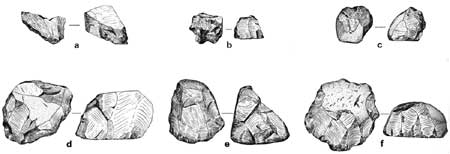
|
| Fig. 122 Planes. Small planes, a-c; and large planes, d-f. Length of d is 9.1 cm. (click on image for an enlargement in a new window) |
The following are dimensions and weights of planes:
| Length (cm.) |
Width (cm.) |
Thickness (cm.) |
Weight (kg.) | ||||||
| Small | Large | Small | Large | Small | Large | Small | Large | ||
| Maximum | 5.3 | 10.7 | 4.3 | 7.8 | 4.4 | 6.5 | 90 | 501 | |
| Minimum | 3.8 | 7.2 | 3.0 | 4.3 | 2.1 | 3.1 | 26 | 154 | |
| Average | 4.5 | 8.7 | 3.5 | 6.7 | 2.9 | 4.7 | 50 | 351 | |
Several of the planes show evidence of additional use as hammerstones, with some of the projections and the retouched edges blunted from pecking or hammering.
Knives or Projectile Points
Four knives or projectile points were found. They are described individually.
Figure 123a. Length 2.9+ cm.; width 2.5 cm.; thickness 0.4 cm.; and weight 4.4+ gm. Translucent black obsidian. Triangular outline; biconvex transverse section and lenticular longitudinal section. Blade sides are convex; shoulder slopes toward the base. Stem expands toward the base. Base is convex with a notch in the middle. Bifacially chipped on the margins of the blade and the stem. Middle of both faces of the blade are unretouched. Tip broken. Small hafted knife or projectile point.
Figure 123b. Length 5.1+ cm.; width 2.7+ cm.; (gm.) thickness 0.5 cm.; and weight, 18+ gm. Buff quartzite. Triangular shape, lenticular sections. Blade sides slightly convex, diagonally side-notched, barbed. Stem probably expands toward base, base broken, one barbed shoulder broken. Bifacially chipped on blade margins. Allover chipping on one face, part of opposite face unretouched. Tip broken. Probably a hafted knife.
Figure 123c. Length 3.8 cm.; width 2.1 cm.; thickness 0.4 cm.; and weight 23 gm. White chalcedony. Triangular shape, lenticular sections. Blade sides slightly concave, diagonally side-notched, barbed. Stem slightly expanding toward base, base is straight. Allover flaking and edge retouching. Probably a projectile point.
Figure 123d. Length 7.0 cm.; width 2.4 cm.; thickness 0.4 cm.; and weight 8.6 + gm. Mottled bluish-gray, brown, buff chalcedony. Triangular shape, lenticular sections. Blade sides straight, bilaterally side-notched at right angles to long axis. Sides below notches change direction and converge slightly. Base is straight; off-center notch in base probably result of accident. Allover flaking with bifacial retouch on the sides. Probably a hafted knife.
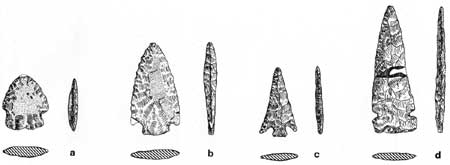
|
| Fig. 123 Knives or projectile points. Length of d is 7 cm. (click on image for an enlargement in a new window) |
None of the points are typical of the period of occupation at Big Juniper House. Obsidian artifacts are rare at Mesa Verde and were probably traded in, or at least the material was brought in, probably from New Mexico. If the obsidian point had been traded in, its distinctiveness could be explained as the work of other people. This point is very similar to "Type 3, Subtype b" points from Pecos, which were predominantly obsidian (Kidder, 1932, p. 22, fig. 7a-f, esp. c).
The quartzite knife seems to be similar to the Basketmaker II points illustrated in Morris and Burgh (1954, figs. 29c and e; 81-2:l and m; and 82-4:h). The barbed chalcedony point is typical of the Pueblo I points found in the Mesa Verde area (O'Bryan, 1950, p. 106; Morris, 1939, p. 126). The large, side-notched chalcedony knife is shaped like the much smaller late Pueblo II-III projectile points. No other knives from the Wetherill Mesa sites appear to be similar to this specimen. However, small side-notched points appear in late Pueblo II, and if this knife was made then, it would not be out of place at Big Juniper House as far as dating is concerned.
Drills
The three drills found are described individually.
Figure 124a. Length 3.0+ cm.; width 1.1 cm.; thickness 0.5+ cm.; and weight 1.8+ gm. Translucent black obsidian. Subtriangular shape; diamond transverse section and lenticular long section. Sides slightly concave, side-notched; straight shoulder. Expanding stem toward base, base probably straight. Part of base broken, one shoulder broken. Allover flaking and bifacial edge retouching. Worn somewhat smooth on tip and upper edges. Tip is angular and may have been re-pointed after a break. Probably a hafted drill.
Figure 124b. Length 4.3 cm.; width 0.9 cm.; thickness 0.3 cm.; and weight 32 gm. Banded gray-brown chert. Ovate shape, lenticular sections. Convex sides, no notches, flat base. Allover flaking with bifacial edge retouching. Not much sign of wear on point or other parts of the drill.
Figure 124c. Length 2.7+ cm.; width 0.9 cm.; thickness 0.7 cm.; and weight 1.8+ gm. Grayish-brown chert. Suboval shape; wedge-shaped transverse section and lenticular long section. Single-shoulder, one straight side; slightly convex side above stem, stem tapers toward base from the shoulder side. Shoulder slopes toward base; base is flat. Allover chipping with bifacial edge chipping on shoulder side. Point broken but shows signs of wear.
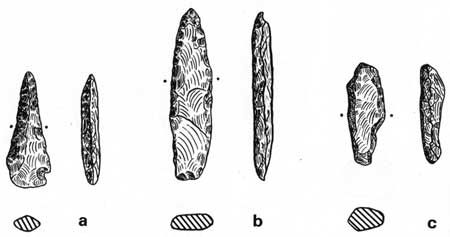
|
| Fig. 124 Drills. Length of b is 4.3 cm. (click on image for an enlargement in a new window) |
Utilized Flakes
Two hundred and twenty-seven flakes in the collection are characterized by having one or more edges flaked or dulled by use. They have been classified into nine groups according to their probable function.
Cutting flakes. This group of 161 flakes is by far the largest (figs. 125 and 126a-c). The varied materials include chert (130); claystone (24); quartzite (4); sandstone (1); coarse-grained igneous rock (1); and concretionary sandstone (1). The shapes are rectangular (41); triangular (34); irregular (26); suboval (21); ovate (10); quadrilateral (9); and miscellaneous (20). Cross sections were predominantly planoconvex (96); others include wedge-shaped (18); flat (15); concavo-convex (12); biconvex (10); uneven (7); and triangular (3).

|
| Fig. 125 Utilized flakes, cutting. Length of a is 7.7 cm. (click on image for an enlargement in a new window) |
Thirty-four of the cutting flakes were singled out as being bladelike in the European use of the term (Burkitt, 1963, p. 49). They are relatively long and narrow, with more or less parallel sides and thin in cross section (fig. 126a-c). Cross sections are usually planoconvex or triangular. A bulb of percussion is always at one end and a hinge fracture occurs frequently at the opposite end. The sides are usually bifacially chipped and nicked by use.
One flake of yellow-red chert was classified as a knife (fig. 126d). It is subtriangular in outline and very thin, but wavy in cross section. It had been bifacially retouched on all three sides, but there is no evidence of modification on the faces.
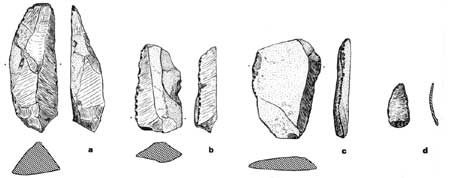
|
| Fig. 126 Utilized flakes; blades, a-c; and knife, Length of a is 9.2 cm. (click on image for an enlargement in a new window) |
The following are dimensions and weights of cutting flakes:
| Length (cm.) |
Width (cm.) |
Thickness (cm.) |
Weight (kg.) | |
| Maximum | 9.2 | 6.6 | 3.9 | 99 |
| Minimum | 2.3 | 1.3 | .2 | 2 |
| Average | 4.8 | 3.4 | 1.1 | 22 |
Cutting and scraping flakes. The 47 flakes, including 5 bladelike specimens, classified as cutting and scraping flakes were of chert or claystone (fig. 127). Shapes are subrectangular (13), subtriangular (11), suboval (5), irregular (5), ovate (4), five-sided (4), quadrilateral (3), lunate (1), and four-sided (1). Sections are: planoconvex (33), concavo-convex (5), wedge-shaped (3), bi-convex (3), uneven (2), and flat (1). Fifteen specimens had nonlustrous, use-abraded edges (fig. 127b and c).

|
| Fig. 127 Utilized flakes, cutting and scraping. Plan views: left side is nicked and chipped from cutting; right side is edge-abraded from scraping. Edge view of a shows chipping; edge views of b and c show edge-abrasion. Lengths: a, 7.8 cm.; b, 4.1 cm. |
Experiments using sharp-edged flakes as cutting and scraping implements were conducted in the Wetherill Mesa Project laboratory. The edges of flakes used to cut or saw the soft, local sandstone became smoothly abraded with mat surfaces (Wheeler, 1965). The edges of flakes used to scrape the parenchyma from yucca leaves and expose the fibers—the material employed commonly in prehistoric times for thread and cordage—were dulled and striated as a result of contact with the hard cobble "anvils" placed beneath the leaves (C. Osborne, 1965).
Other aspects suggesting scraping are the concave edges, which are more suitable for scraping than cutting, and the small notches with use-chipping, as if some thing had been scraped inside the notch.
The following are dimensions and weights of cutting and scraping flakes:
| Length (cm.) |
Width (cm.) |
Thickness (cm.) |
Weight (kg.) | |
| Maximum | 6.8 | 5.5 | 2.2 | 67 |
| Minimum | 2.8 | 2.0 | .4 | 4 |
| Average | 4.7 | 3.4 | 1.2 | 23 |
Scraping flakes. Only four flakes were classified as having the single function of scraping (fig. 128). All were of chert or claystone. Sections were biconvex (2) and planoconvex (2). Outlines are irregular (1), ovate (1), and subtriangular (2). Three of the four had the nonlustrous, abraded edges described previously. The ranges in measurements are: length 3.4 to 5.0 cm.; width 2.1 to 4.4 cm.; thickness 1.0 to 1.6 cm.; and weight 9 to 38 gm.
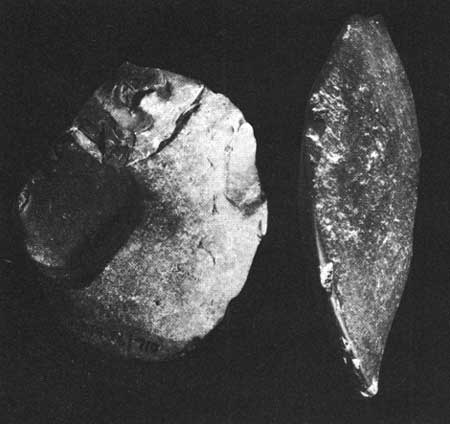
|
| Fig. 128 Utilized flake, scraping. Side view shows edge-abrasion. Length is 5 cm. |
Cutting and chopping flakes. Five flakes were used for cutting and chopping (fig. 129c). Chopping is inferred from battered and blunted edges and projections. Materials include claystone (2), quartzite (2), and quartzitic sandstone (1). All sections are planoconvex and shapes are quadrilateral, subrectangular, four-sided, subtriangular, and ovate. The ranges in measurements are: length 4.8 to 7.5 cm.; width 2.9 to 5.1 cm.; thickness 1.6 to 2.3 cm.; and weight 31 to 75 gm.
Chopping flakes. Five flakes were used for chopping only (fig. 129a and b). Materials are claystone or chert (4), and sandstone (1). Sections are planoconvex (4) and wedge-shaped (1). Outlines are subrectangular, four-sided, discoidal, suboval, and ovate. Ranges in measurements are: length 4.3 to 6.3 cm.; width 4.0 to 5.7 cm.; thickness 1.5 to 2.0 cm.; and weight 37 to 74 gm.
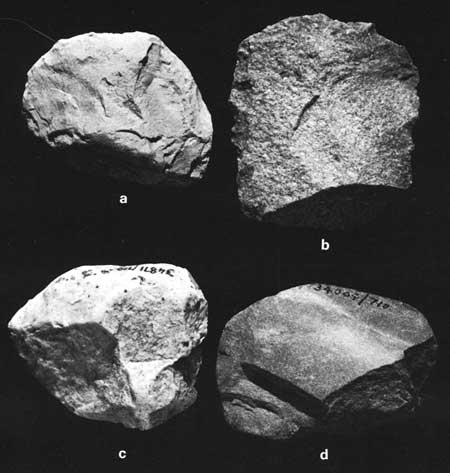
|
| Fig. 129 Utilized flakes: chopping, a, b; cutting and chopping, c; and cutting, scraping, and pounding, d. Length of a is 6 cm. (click on image for an enlargement in a new window) |
Cutting, scraping, and pounding flake. One flake of claystone, 6.7 by 5.0 by 2.6 cm. and weighing 88 gm., had been chipped by use in cutting and scraping, and blunted through use in pounding (fig. 129d).
Sawing flake. One chert flake with a serrated edge indicated a sawing function (fig. 130a). The "teeth" were slightly worn, as would be expected if the flake had been used for sawing. It is suboval in outline and planoconvex in longitudinal and transverse sections. Measurements are 3.7 by 2.5 by 1.1 cm., and weight is 67 gm.
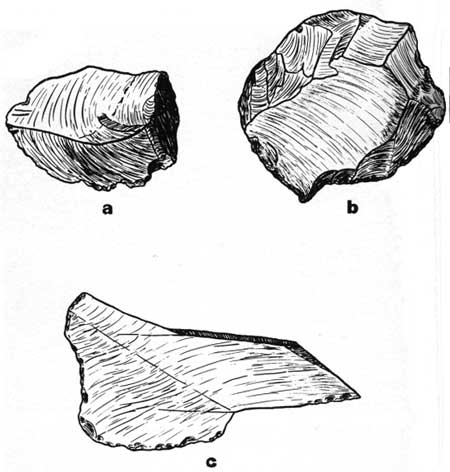
|
| Fig. 130 Utilized flakes: sawing, a; cutting and drilling, b; and cutting and punching, c. Length of c is 6.1 cm. |
Drilling and cutting flakes. Two chert flakes had worn and dulled points in addition to chipped edges, indicating use for drilling as well as cutting. The upper margins next to the points were also worn and slightly polished as if used for drills. A quadrilateral-shaped flake had an irregular cross section and measured 3.8 by 2.1 by 1.0 cm., and weighed 6 gm. A discoidal-shaped flake (fig. 130b) had planoconvex sections; it measured 4.6 by 3.7 by 1.2 cm., and weighed 21 gm.
Cutting and punching flake. One chert flake, irregular-shaped with flat sections, had a sharp point which was probably used for punching in addition to having edges for cutting purposes (fig. 130c). It measures 6.1 by 2.9 by 0.6 cm., and weighs 13 gm.
Utilized Cores
Fourteen cores were utilized for cutting, chopping, and scraping, or combinations of these functions (fig. 131). Materials used were chert or claystone (13), and quartzite (1). Sections are planoconvex (7), biconvex (3), triangular (1), irregular (1), wedge-shaped (1), and flat (1). Outlines are suboval (4), subtriangular (3), irregular (2), discoidal (2), and pyramidal, ovate, and five-sided (1 each).
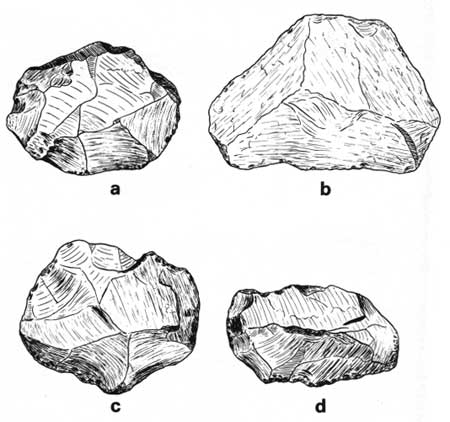
|
| Fig. 131 Utilized cores. Length of b is 8.4 cm. |
The following are measurements and weights of utilized cores:
| Length (cm.) |
Width (cm.) |
Thickness (cm.) |
Weight (kg.) | |
| Maximum | 8.4 | 5.9 | 3.5 | 127 |
| Minimum | 3.1 | 3.1 | 1.7 | 23 |
| Average | 5.4 | 4.2 | 2.7 | 67 |
Anvils
Three irregular-shaped cobbles of quartzitic sandstone were classified as anvils (fig. 132). The faces were pecked and battered (one had scratches in a restricted area), as if they had been used as platforms. Measurements are: lengths 11.7, 13.4, and 20.5 cm.; widths 10.2, 11.2, and 8.8 cm.; thickness 6.1, 5.2, and 5.5 cm.; and weights 1.0, 1.2, and 1.5 kg.
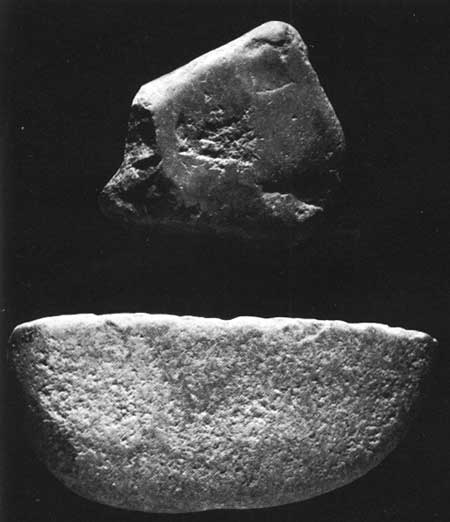
|
| Fig. 132 Anvils. Length of lower artifact is 20.5 cm. |
| <<< Previous | <<< Contents>>> | Next >>> |
archeology/7c/chap4a.htm
Last Updated: 16-Jan-2007
